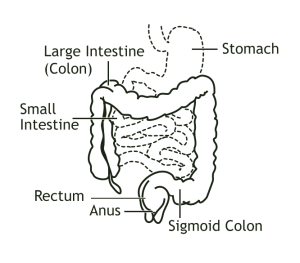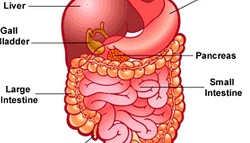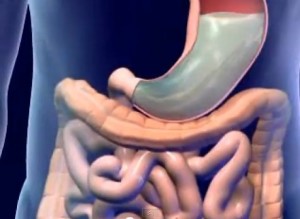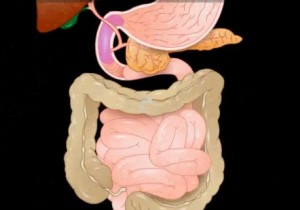Digestive system consists of a chain of organs which are connected to each other with a tube. This tube twists from mouth to the end part i.e. anus. There are additional organs as well which help to split food and get it absorbed in the body. The digestive tract consists of the organs in the pattern given below pattern. They are namely:
- Mouth
- Esophagus
- Stomach
- Small intestine
- Large intestine
- Rectum
- Anus
The interior of the above organs have a coating which is known as mucosa. This mucosa has small gland which produces juice and this juice helps in the digestion of food. All these organs also have a coating of soft muscles. The function of these soft muscles is to break the food and push it from one organ to the other organ. Digestive juice is produced by liver and pancreas. Juices are passed from ducts (which are tiny tubes) to the intestines. But before it is passed on to the intestines the gall bladder store up the juice till it is required. Two other important systems that perform main role in the digestive system are nervous system and circulatory system.
Importance of Digestive System
Foods when eaten are not in the type which will be nourishing. These foods have to be turned into molecule of healthy nutrient. After that these nutrients are absorbed by the blood and then are passed on to the other parts of the body. Thus digestive system is important as due to this process the foods are broken down into nutrients and then carried on to the other cells; this way the body is built, nourished and is energized.
Digestion of Food in the Digestive System
When food is eaten it is mixed with juices secreted from liver and pancreas for digestion, then it passes along the digestive tract and then food is broken down into small molecules to be absorbed by the blood and gradually sent to the entire body. The process starts from mouth and gets complete in the small intestine.
Production of Digestive Juices in the Digestive System
In the digestive system the process begins from mouth. In the mouth are salivary glands. In these glands saliva is produced which has enzymes which helps in digestion of starch. These enzymes help in the breaking down of food into small molecules. The second phase is in the stomach. Stomach mucosa produces stomach acid and enzymes (which help in the digestion of protein). Mucosa also has a coating of mucus which prevents the acid juice to dissolve the tissues of stomach. After the food passes from stomach to the smaller intestines, the digestive juices from pancreas and liver gets mixed with the foods. Bile juice is produced by liver which dissolves the fat to fluid content. This fluid content is absorbed by the enzyme from mucosa and pancreas. Digestive juice produced by pancreas helps in the breaking down of fat, protein and carbohydrates.
Absorption and Transportation in the Digestive System
Mostly the smaller molecules of foods are absorbed by the small intestines. Mucosa of the smaller intestine consists of many creases which have covers known as ‘villi’. These villi are like small finger like protrusions and further villi have covers known as ‘microvilli’. Microvilli are microscopic protrusions. Formations of this create a huge area so that the nutrients are absorbed. There are special cell which permits these absorbed nutrients to move from mucosa into the blood. Further it is distributed to the rest of the body for chemical changes or to store it. This process differs with the different nutrient. Some of the nutrients are protein, vitamins, carbohydrates, fat, water and salt.
Controlling the Digestive Processes in the Digestive System
There are various regulators to control the digestive processes. They are as follows:
- Hormone Regulators and
- Nerve Regulators
Hormone Regulators: The main hormones that help in controlling the functioning in digestive system are created and released by cells. These cells are in the lining of stomach and smaller intestines. After the hormones enter in the blood they move to the heart and then arteries and later return to the digestive system to fuel the digestive juice for further organ movements. The important hormones helps in controlling digestion are:
- Secretin: Secretin makes the pancreas release juice which has bicarbonate. Bicarbonate further defuses the stomach acid when it enters the smaller intestine. Further it causes the stomach to generate an enzyme called pepsin. This pepsin helps in digestion of protein and stimulation of the liver for production of bile.
- Gastrin: Due to gastrin the stomach produces an acid which dissolves and digests food. Also it is important for good growth of cells in the muscles layer of large intestine, smaller intestine and stomach.
- Cholecystokinin (short form CCK): Pancreas produces juices and makes the gallbladder bare. It is caused due to Cholecystokinin which is also known as CCK. CCK also helps in the good growth of cells in the pancreas.
There are some other hormones also like ghrelin and peptide YY which help in regulation of appetite in the digestive system.
Nerve Regulators
There are two kinds of nerves that help in controlling the digestion, namely:
- Intrinsic nerves: These nerves form a thick network surrounded in the wall of esophagus, belly, smaller intestine and large intestine. When these empty organs stretches by food the intrinsic nerves react by releasing substances that may speed up or slow up the movements of food and production of juice by the organs of digestion system.
- Extrinsic nerves: Adrenaline and acetylcholine chemicals are released by these nerves. Acetylcholine speeds up the production of digestives juices. It makes the muscle linings of the organs of the digestion system to work with extra energy. Adrenaline is just the reverse. It relaxes the linings and lessens the blood flow. This may further lessen or stop the digestion.
Thus the nerve regulators, hormone regulators, digestive system organs and blood jointly perform the difficult task to digest and absorb the nutrients derived from food and liquid that is consumed.
Human digestive system diagrams


Digestive system pictures


